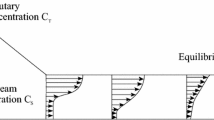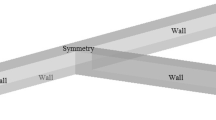Abstract
Lateral intake is a hydraulic structure which is broadly used for purposes such as agricultural consumption or urban water supply. To improve the efficiency of this structure, it is common to install a submerged vane near the entrance of this structure. Despite common applications of this structure, there is still a lack on correct description of flow structure near this structure and the variability of flow characteristics due to the geometrical characteristics such as lateral intake angle. In present study, we numerically investigate the role of submerged vane and lateral intake angle on flow structure using FLOW-3D simulation package. The results show that the lateral intake with 45° angle has the highest efficiency which can transport the highest amount of water together with lowest amount of sediments to the lateral intake. Moreover, it is also found that formation of a circulation zone between submerged vane and main channel lateral wall causes a high amount water to enter to the lateral intake with the lowest amount of sediment. Finally, simulations of flow in the presence of two submerged vanes show that two submerged vanes installed in a straight line and in a parallel configuration have higher efficiency in conveying water to lateral intake with low amount of sediment.











Similar content being viewed by others
References
Asnaashari A, Merufinia E (2015) Numerical simulation of velocity distribution in the river lateral intake using the SSIIM2 numerical model. Cumhur Sci J 36(3):1473–1486
AEA Industrial Technology plc (2014) FLOW-3D user guide-version 6.3.26, CFD Department, Harwell Laboratory
Barkdoll BD, Hagen BL, Odgaard AJ (1998) Experimental comparison of dividing open-channel with duct flow in T-junction. J Hydraul Eng 124(1):92–95
Chow VT (1959) Open channel hydraulics. McGraw-Hill, New York, p 680
Davoodi L, Bejestan MS (2012) Control of sediment entry to intake on a trapezoidal channel by submerged vane. Ecol Environ Conserv 18(1):165–169
Esmaeili Varaki M, Farhoudi J, Walker D (2011) Study of flow structure and sediment entry to a lateral intake. In: Proceedings of the Institution of Civil Engineers-Water Management, vol 164, no. 7. Thomas Telford Ltd., pp 347–360
Goudarzizadeh R, Hedayat N, Jahromi S (2010) Three-dimensional simulation of flow pattern at the lateral intake in straight path, using finite-volume method. World Acad Sci Eng Technol 47:656–661
Habibi L, Keshavarzi A (2007) Optimizing river intake angle by flow separation analysis in Damless Water Intake. In: 7th International river engineering conference, Iran, Ahvaz
Haddad H, Ahmad E, Azizi K (2017) Numerical simulation of the inlet sedimentation rate to lateral intakes and comparison with experimental results. J Res Ecol 5(1):464–472
Mehnifard M, Dalfardi S, Baghdadi H, Seirfar Z (2015) Simulation of local scour caused by submerged horizontal jets with Flow-3D numerical model. Desert 20(1):47–55
Mirzaei SHS, Ayyoubzadeh SA, Firoozfar AR (2014) The effect of submerged-vanes on formation location of the saddle point in lateral intake from a straight channel. Am J Civil Eng Archit 2(1):26–33
Moghadam MK, Bajestan MS, Sedghi H (2010) Sediment entry investigation at the 30 degree water intake installed at a trapezoidal channel. World Appl Sci J 11(1):82–88
Neary VS, Sotiropoulos F (1996) Numerical investigation of laminar flows through 90-degree diversions of rectangular cross-section. Comput Fluids 25(2):95–118
Ouyang HT, Lai JS (2013) Design optimization of a submerged vane with streamlined profile for sediment management in rivers. J Mar Sci Technol 21(3):325–332
Ouyang HT, Lin CP (2016) Characteristics of interactions among a row of submerged vanes in various shapes. J Hydro Environ Res 13:14–25
Răzvan E (1989) River intakes and diversion dams, 25th edn. Elsevier, New York
Seyedian SM, Bajestan MS, Farasati M (2014) Effect of bank slope on the flow patterns in river intakes. J Hydrodyn Ser B 26(3):482–492
Van Rijn LC (1984) Sediment transport, part I: bed load transport. J Hydraul Eng 110(10):1431–1456
Vanoni VA (1977) Sedimentation engineering. ASCE manual, 54
Author information
Authors and Affiliations
Corresponding author
Rights and permissions
About this article
Cite this article
Rahmani Firozjaei, M., Salehi Neyshabouri, S.A.A., Amini Sola, S. et al. Numerical Simulation on the Performance Improvement of a Lateral Intake Using Submerged Vanes. Iran J Sci Technol Trans Civ Eng 43, 167–177 (2019). https://doi.org/10.1007/s40996-018-0126-z
Received:
Accepted:
Published:
Issue Date:
DOI: https://doi.org/10.1007/s40996-018-0126-z




